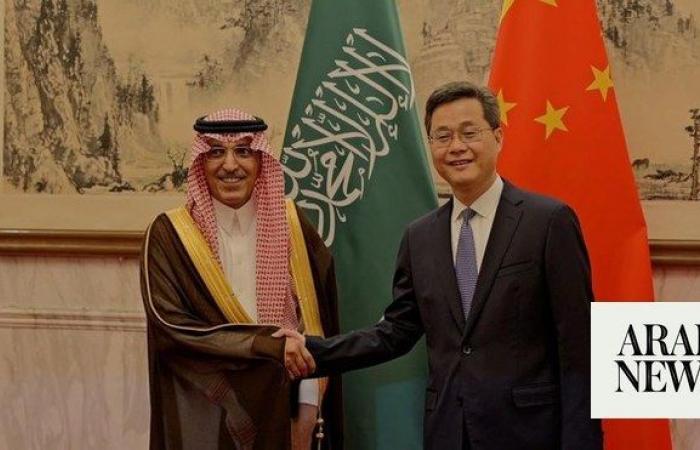Thank you for reading the news about Saudi Arabia’s non-oil exports surge as trade ties with China flourish and now with the details
Jeddah - Yasmine El Tohamy - RIYADH: Saudi Arabia exported non-oil goods worth SR2.23 billion ($594 million) in May, representing a rise of 19.25 percent compared to the previous month, official data showed.
According to the General Authority for Statistics, China was the third-largest destination for Saudi Arabia’s non-oil products in May, behind the UAE and China, which received goods worth SR6.06 billion and SR3.62 billion, respectively.
Strengthening the non-oil private sector and exporting those goods to countries like China is crucial for Saudi Arabia, as the Kingdom is steadily pursuing its economic diversification journey by reducing its dependence on oil.
The report revealed that China was also the top destination for Saudi Arabia’s overall exports, with the Kingdom sending outgoing shipments amounting to SR15.91 billion.
In May, oil was the main export from Saudi Arabia to South Korea, with shipments totaling SR13.68 billion.
According to the latest data, Saudi Arabia exported plastics and rubber products worth SR876.9 million to China, followed by chemical products at SR851.8 million.
In May, the Kingdom also exported mineral products totaling SR313.4 million to China, while outgoing shipments of base minerals amounted to SR103.7 million.
China was also Saudi Arabia’s most important import partner in May, with incoming shipments from the Asian nation amounting to SR17.55 billion, representing a rise of 22 percent compared to April.
According to GASTAT, China was followed by the US and the UAE, with the Kingdom importing goods worth SR6.56 billion and SR4.54 billion, respectively, from these nations.
The authority revealed that Saudi Arabia imported mechanical equipment and electrical parts worth SR8.23 billion in May from China.
The Kingdom also imported transport equipment and base metals worth SR2.68 billion and SR1.61 billion, respectively, in May.
Chinese imports to the Kingdom also included antiques and artworks worth SR961.8 million, followed by plastic products at SR806.7 million and textile goods at SR792.4 million.
In May, Saudi Arabia also imported chemical products worth SR479.5 million, while the Kingdom also received incoming shipments of leather, fur, and handbags from China amounting to SR118.4 million.
A blossoming relationship
Saudi Arabia and China have shared strong bilateral relations for several years, with the Kingdom being the largest trading partner of China in the Middle East since 2001, and bilateral trade between the nations reaching $107.23 billion in 2023.
The Kingdom and China are strategic partners in various sectors, including energy and finance, as well as the Belt and Road Initiative.
According to the Chinese government, one out of every six barrels of crude oil imported by China comes from Saudi Arabia, while every Saudi riyal out of every SR7 of the Kingdom’s export revenue comes from the Asian nation.
In May, Saudi Finance Minister Mohammed Al-Jadaan spoke highly of the economic and trade cooperation between the two countries, saying that the two countries have maintained positive cooperative communication under the framework of the Economic and Financial Subcommittee of the High-level Chinese-Saudi Joint Committee.
Al-Jadaan also noted that bilateral trade between the two countries surged 31-fold since 1990, adding that outbound investment from China into Saudi Arabia has also been growing rapidly in recent years, making the Asian nation an important partner for the Arab country to realize its vision for economic transformation.
As the diplomatic and economic relationship between Saudi Arabia and China prospers, the Kingdom’s Central Bank, also known as SAMA, and the People’s Bank of China, in November 2023, signed a local currency swap agreement worth SR26 billion ($6.93 billion).
After the agreement, SAMA said that the deal would help strengthen financial cooperation between Saudi Arabia and China, promote the use of local currencies, and strengthen trade and investments between the countries.
Major developments
The first half of this year witnessed several major developments that could enhance the bilateral, economic, and trade relationships between Saudi Arabia and China.
Earlier this month, Saudi Arabia’s sovereign wealth fund signed six deals amounting to $50 billion with top Chinese financial institutions to enhance bilateral capital flows.
In a press statement, the Public Investment Fund said that it signed memoranda of understanding with China Construction Bank, Agricultural Bank of China, China Export and Credit Insurance Corp., Bank of China, Export-Import Bank of China, and the Industrial and Commercial Bank of China.
According to the statement, these agreements will focus on facilitating two-way capital flows through both debt and equity between Saudi Arabia and China.
In the same month, Saudi Basic Industries Corp. signed a potential investment agreement with the Fujian government in China to develop an engineering thermoplastic compounding plant in the Asian nation.
In July, the stock exchange relationship between both nations strengthened further as two new exchange-traded funds focused on the Kingdom’s stocks debuted in Shanghai and Shenzhen.
The first fund, CSOP Saudi Arabia ETF QDII, managed by China Southern Asset Management, is listed on the Shenzhen Stock Exchange after raising $87 million.
The second fund, the Huatai-PineBridge managed CSOP Saudi Arabia ETF QDII, started trading on the Shanghai Stock Exchange after raising $82.32 million.
The debut of these ETFs in Chinese exchanges occurred at a time when investor relations between the two nations continued to flourish, with China becoming the top greenfield foreign direct investor in the Kingdom with investments amounting to $16.8 billion in 2023, representing a 1,020 percent rise compared to the previous year.
China and Saudi Arabia are also deepening their relationship in the tourism sector, with the implementation of the Approved Destination Status arrangement, which came into effect on July 1.
The Chinese ADS policy is a bilateral agreement between countries that allows its citizens to travel to specific overseas destinations for tourism purposes in organized groups.
The decision to implement ADS aligns with Saudi Arabia’s goal of attracting 5 million Chinese tourists by 2030, facilitated by new direct flights from Air China, China Eastern, and China Southern, alongside existing Saudia flights.
In June, the Saudi Tourism Authority and Taiba Investments, a major hospitality and real estate firm in the Kingdom, also signed another agreement to develop integrated residential ecosystems and a specialized network of hotels catering to tourists from China.
In the same month, Riyadh Air, backed by the PIF, signed an agreement with China Eastern Airlines to enhance future connectivity and collaborate on digital transformation, further cementing its entry into the Chinese market.
“Our partnership with Air China, a leading global carrier with a vast network in key Chinese markets, complements Riyadh Air’s ambitious future plans,” said Tony Douglas, CEO of Riyadh Air, at that time.
The agreement also focuses on interline connectivity, codeshare arrangements, and potential collaboration in frequent flyer programs as well as cargo services, customer experience, and digital innovation.
On the cultural front, King Abdulaziz Public Library in Riyadh, in August, implemented an initiative to introduce Saudi culture to Chinese-speaking audiences through its publishing program.
As part of this program, a series of scientific, cultural, and literary works in Arabic were selected for translation into various languages, including Chinese.
According to an official statement, the primary purpose of this initiative is to present a comprehensive portrait of contemporary Saudi culture to Chinese readers.
These were the details of the news Saudi Arabia’s non-oil exports surge as trade ties with China flourish for this day. We hope that we have succeeded by giving you the full details and information. To follow all our news, you can subscribe to the alerts system or to one of our different systems to provide you with all that is new.
It is also worth noting that the original news has been published and is available at Arab News and the editorial team at AlKhaleej Today has confirmed it and it has been modified, and it may have been completely transferred or quoted from it and you can read and follow this news from its main source.


